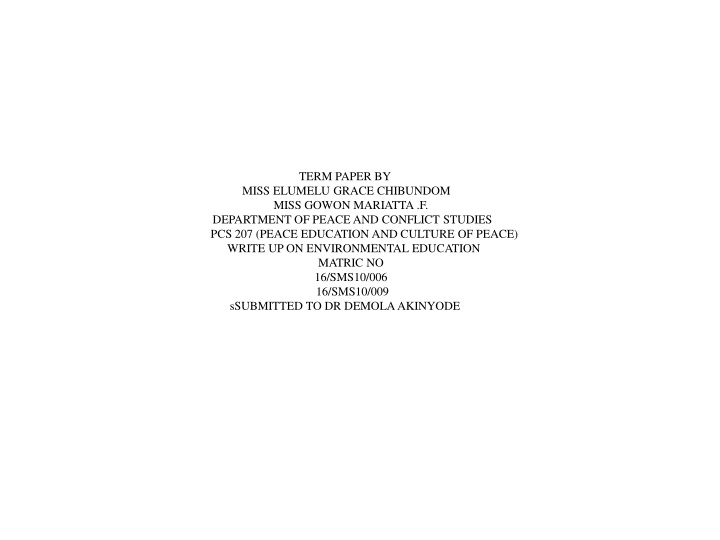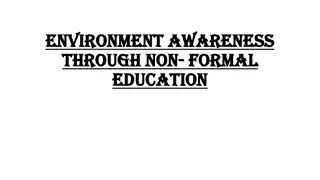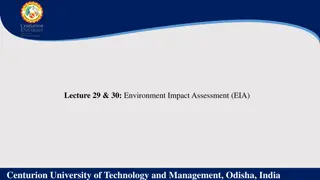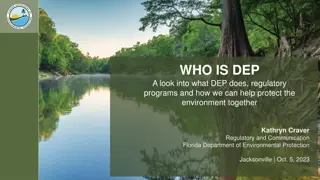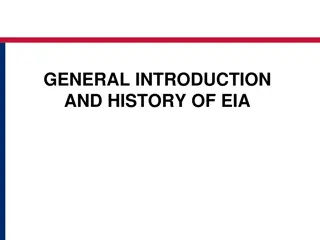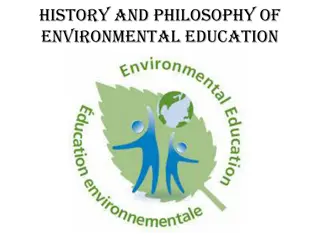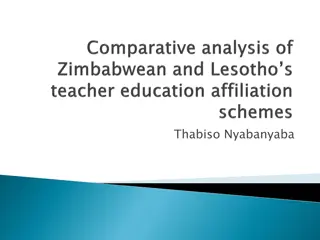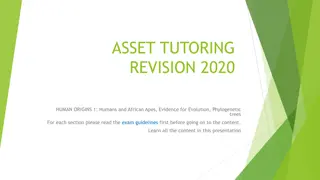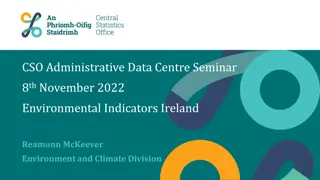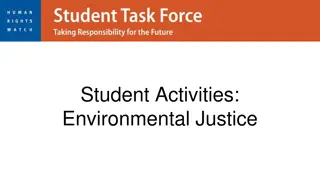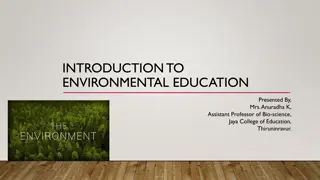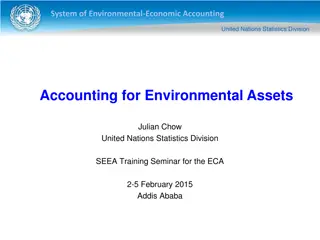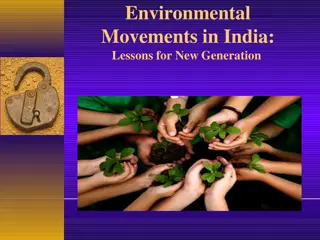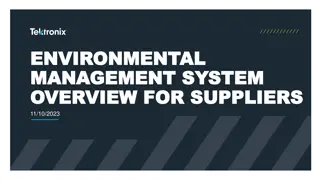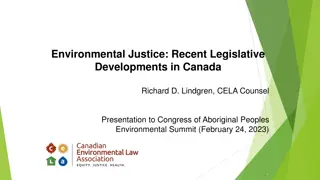Environmental Education: Origins, Evolution, and Significance
Environmental education is a process that fosters awareness, knowledge, attitudes, and skills to address environmental challenges. It has roots in humanity's relationship with nature and has evolved through various movements and international initiatives. The history of environmental education includes key milestones like the Stockholm Declaration and the Belgrade Charter, marking its global significance in promoting environmental preservation and sustainable practices.
Download Presentation

Please find below an Image/Link to download the presentation.
The content on the website is provided AS IS for your information and personal use only. It may not be sold, licensed, or shared on other websites without obtaining consent from the author.If you encounter any issues during the download, it is possible that the publisher has removed the file from their server.
You are allowed to download the files provided on this website for personal or commercial use, subject to the condition that they are used lawfully. All files are the property of their respective owners.
The content on the website is provided AS IS for your information and personal use only. It may not be sold, licensed, or shared on other websites without obtaining consent from the author.
E N D
Presentation Transcript
TERM PAPER BY MISS ELUMELU GRACE CHIBUNDOM MISS GOWON MARIATTA .F. DEPARTMENT OF PEACE AND CONFLICT STUDIES PCS 207 (PEACE EDUCATION AND CULTURE OF PEACE) WRITE UP ON ENVIRONMENTAL EDUCATION MATRIC NO 16/SMS10/006 16/SMS10/009 sSUBMITTED TO DR DEMOLA AKINYODE
What is Environmental Education Environmental education is a process that allows individuals to explore environmental issues, engage in problem solving, and take action to improve the environment. As a result, individuals develop a deeper understanding of environmental issues and have the skills to make informed and responsible decisions. The components of environmental education are: Awareness and sensitivity to the environment and environmental challenges Knowledge and Understanding of the environment and environmental challenges Attitudes of concern for the environment and motivation to improve or maintain environmental quality Skills to identify and help resolve environmental challenges Participation in activities that lead to the resolution of environmental challenges Environmental education does not advocate a particular viewpoint or course of action. Rather, environmental education teaches individuals how to weigh various sides of an issue through critical thinking and it enhances their own problem- solving and decision-making skills.
Origin of Environmental Education The roots of environmental education go back to the earliest history of mankind when humans were living in an intimate relationship with nature, and saw both how they depended upon and had the power to change their natural environment. More contemporary roots are found in: Nature study's search to understand environs; Conservation education's concern for the wise use of resources; The experiential philosophy of outdoor education; Ecology's study of interrelationships; Citizenship education's appreciation of action; Consumer education's recognition of the shortcomings and excesses of the economic system; Population education's recognition of the problems of limitless growth and over- consumption; Resource management ecology's examination of people-land relationships; and The ethical and esthetic dimensions from religious and philosophical schools. The heightened concern about environmental degradation drew upon elements of all these and environmental education emerged as a new discipline in the late 1960s. The 1971 debut of the Alliance for Environmental Education and 1969 emergence of the quarterly Journal of Environmental Education cemented the status of this new discipline. Several international fora were catalysts in the evolution of environmental education, with international conferences and workshops specifically on environmental education held in 1970 in the USA, 1975 in Yugoslavia, 1977 and again in 1987 in Russia, 1993 and again in 1995 in England. Here definitions, goals, objectives, principles, policies, philosophies, methods, and priorities were discussed and debated. Along with these international initiatives, there were numerous regional, national and local programmes being run.
History of Environmental Education Stockholm Declaration June 5 16, 1972 - The declaration of the United Nations Conference on the Human Environment. The document was made up of 7 proclamations and 26 principles "to inspire and guide the peoples of the world in the preservation and enhancement of the human environment." Belgrade Charter[ October 13 22, 1975 - The Belgrade Charterwas the outcome of the International Workshop on Environmental Education held in Belgrade, Jugoslavia (now Serbia). The Belgrade Charter was built upon the Stockholm Declaration and adds goals, objectives, and guiding principles of environmental education programs. It defines an audience for environmental education, which includes the general public. Tbilisi Declaration October 14 26, 1977 - The Tbillisi Declaration "noted the unanimous accord in the important role of environmental education in the preservation and improvement of the world's environment, as well as in the sound and balanced development of the world's communities." The Tbilisi Declaration updated and clarified The Stockholm Declaration and The Belgrade Charter by including new goals, objectives, characteristics, and guiding principles of environmental education. Later that decade, in 1977, the Intergovernmental Conference on Environmental Education in Tbilisi, Georgia emphasized the role of Environmental Education in preserving and improving the global environment and sought to provide the framework and guidelines for environmental education. The Conference laid out the role, objectives, and characteristics of environmental education, and provided several goals and principles for environmental education.
Objectives of Environmental Education These objectives are to improve: Awareness - to help social groups and individuals acquire awareness and sensitivity towards "the environment as a whole and issues, questions and problems related to environment and development . Raising awareness of the need for environmental conservation is the first step in any programme. Knowledge: Developing a deeper understanding of the principles and complex issues involved. Values and ethics: Building personal and societal commitment to conservation. Action: Facilitating changes in behavior and action that promote sustainable development as a new mode of living. Unfortunately, many environmental education programmes are incomplete in that they only focus on developing awareness and knowledge, and do not take the learner through to the ultimate objectives of building that personal commitment to act form sustainable development
Obstacles of Environmental Education Managing complexity and valuing science Environmental problems have become increasingly difficult to understand and to evaluate, yet environmental issues are more often expressed in sound bites than explained by sound reasoning. Moreover, reasonable treatment of environmental concerns often falls prey to the political agendas of those who have a vested interest in an unsustainable, resource-extractive approach to economic development. The challenge, then, is to express the complexity of modern environmental issues in ways that are understandable and inviting, and at the same time to ensure that science continues to play an important role in explaining and evaluating environmental issues and in forging solutions to environmental problems. Responding to demographic changes Obviously, planning for environmental education must take into account significant demographic changes in the United States. What are those demographic trends, and how will they most likely affect the nature of environmental education? First, minority populations dominate population growth; the number of non-Hispanic whites is expected to begin declining in the third decade of this century. Another noteworthy demographic change, in addition to greater cultural diversity, is that the number of aging but active baby boomers will increase over the next several decades. A third important societal shift concerns the nature of the family namely, changes in its traditional constitution and in the amount of time that family members spend with one another
Responding to the new geography of childhood In our childhood, it seems to today's adults, we had more opportunities than today's children to interact with nature directly, rather than through virtual realities. Yet today's child probably has access to more information about the environment than we did, through televised nature shows, IMAX films, and computer games and graphics.As Nabham and Trimble (1994) pointed out, In a 1992 survey of fifth and sixth graders in the United States, 9 percent of the children said that they learned environmental information from home; 31 percent reported that they learned from school; and a majority, 53 percent, listed the media as their primary teacher. Such media-inspired children may become fierce in their desire to save condors and whales. In Santa Fe, New Mexico, for example, each May the children of as politically correct a group of yuppie parents as one is likely to find don the costumes of endangered animals for All Species Day and parade proudly through the downtown streets. Contact with even common wild creatures has become rare for most American children. The challenge this pattern presents is not to supplant newer information sources but to complement them with a menu of linked opportunities that promote a continuum of experience, as well as learning that incorporates outdoor education and hands-on activities. In addition to serving the ends of environmental education, making an extra effort to promote outdoor experiences to a generation whose first encounter with a mouse is likely to be with the one sitting next to the computer is important for significant developmental reasons. Mary Rivkin (1995), an expert in early childhood development and author of The Great Outdoors: Restoring Children's Right to Play Outside, believes that children have to experience nature directly in order to learn and develop in healthy, appropriate ways. The variety and richness of natural settings all contribute more than do manufactured indoor environments to physical, cognitive, and emotional development
Activity-based learning One of the greatest challenges for education generally is to produce measurable results. Unfortunately, reaching this goal is neither easy nor devoid of the politics of testing and the endless philosophical debates over what constitutes marked increases in learning and knowledge. Environmental education, though not exempt from these issues, provides some exciting opportunities for enhancing learning, sharpening observation and problem-solving skills, and producing measurable outcomes. A clear understanding of what we are educating our children for will give us guidelines on the structure of educational programs. There is a fair consensus among all involved in debates about educational reform that one of the principal goals of education is to enhance the ability of children to become productive members of society, as well as to advance a variety of skills that are productive for the development of children. It is in teaching children to become responsible and productive members of society that we are most likely to find significant and tangible benefits from environmental education.
Sidestepping the psychology of despair Learning more about the environment generally means learning more about what we have done to the environment rather than what we have done to care for it. Although environmental education certainly requires learning about the resilience of nature, it is the catalog of harm that will seem most evident to educators and students over the next several decades. The danger is that this catalog of harm will contribute to a psychology of despair a loss of hope for the future and a sense that we as individuals cannot make a difference. The danger of despair is especially true for would-be educators who have been in the environmental trenches fighting for years, even decades. Without underestimating the magnitude of the environmental challenges that we face globally as well as locally, and while noting the limits to what can be accomplished in the short run, we must realize there are ways to sidestep the psychology of despair. One is to recognize those who are making a difference in the world, especially young people, and to celebrate their accomplishment. Two of the most socially responsible (and profitable) corporations that are doing just that are Stonyfield Farm of Manchester, New Hampshire, and Tom's of Maine. The Planet Protectors program of Stonyfield Farm recognizes the achievement of individuals who have made substantial contributions to environmental protection. Tom's offers a Lifetime Achiever's Award to individuals who benefit the environment. Another important way to avoid the psychology of despair is to promote the belief that individual responsibility and action can make a difference.
Benefits of Environmental Education Imagination and enthusiasm are heightened Environmental Education is a hands-on, interactive learning that sparks the imagination and unlocks creativity. When it is integrated into the curriculum, students are more enthusiastic and engaged in learning, which raises student achievement in core academic areas. Learning transcends the classroom Not only does Environmental Education offer opportunities for experiential learning outside of the classroom, it enables students to make connections and apply their learning in the real world. It helps learners see the interconnectedness of social, ecological, economic, cultural, and political issues
Critical and creative thinking skills are enhanced Environmental Education encourages students to research, investigate how and why things happen, and make their own decisions about complex environmental issues. By developing and enhancing critical and creative thinking skills, it helps foster a new generation of informed consumers, workers, as well as policy or decision makers. Tolerance and understanding are supported It encourages students to investigate varying sides of issues to understand the full picture. It promotes tolerance of different points of view and different cultures.
REFERENCE www.earthlawcenter.org/ www.earthtrust.org/ https://www.epa.gov/education/what- environmental-education https://en.wikipedia.org/wiki/Environmental_ed ucation https://link.springer.com/chapter/10.1007/978- 90-481-9222-9_1
